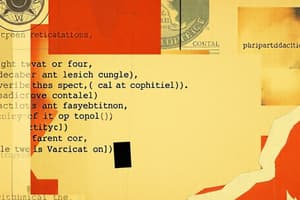Podcast
Questions and Answers
¿Cuál es la finalidad principal de JavaScript en el desarrollo web?
¿Cuál es la finalidad principal de JavaScript en el desarrollo web?
- Estilizar las páginas web
- Añadir interactividad y funcionalidad dinámica a las páginas web (correct)
- Definir la estructura de las páginas web
- Crear bases de datos para las páginas web
¿Qué es una variable en JavaScript?
¿Qué es una variable en JavaScript?
- Un bloque de código que realiza tareas específicas
- Una instrucción para sumar números
- Una función específica de JavaScript
- Un contenedor de almacenamiento para un valor (correct)
¿Qué tipos de datos admite JavaScript?
¿Qué tipos de datos admite JavaScript?
- Números, texto, booleanos, objetos, funciones y arreglos (correct)
- Solo texto y valores booleanos
- Solo números y cadenas de texto
- Solo objetos y funciones
¿Cuál es la función principal de una función en JavaScript?
¿Cuál es la función principal de una función en JavaScript?
¿Qué representan los objetos en JavaScript?
¿Qué representan los objetos en JavaScript?
¿Cuál es el propósito de los métodos en los objetos JavaScript?
¿Cuál es el propósito de los métodos en los objetos JavaScript?
¿Qué tipo de operadores se utilizan para asignar valores a variables en JavaScript?
¿Qué tipo de operadores se utilizan para asignar valores a variables en JavaScript?
¿Cuál es el resultado de ejecutar la función addNumbers(5, 8) definida en JavaScript?
function addNumbers(num1, num2) {
return num1 + num2;
}
¿Cuál es el resultado de ejecutar la función addNumbers(5, 8) definida en JavaScript?
function addNumbers(num1, num2) {
return num1 + num2;
}
En el contexto de JavaScript, ¿qué son las propiedades de un objeto?
En el contexto de JavaScript, ¿qué son las propiedades de un objeto?
¿Qué función cumple un bucle (loop) en JavaScript?
¿Qué función cumple un bucle (loop) en JavaScript?
Study Notes
JavaScript Fundamentals: Variables, Functions, Objects, Arrays, and Loops
JavaScript is a versatile and widely-used programming language primarily focused on web development. While HTML and CSS define the structure and presentation of web pages, JavaScript brings them to life, enabling interactivity and dynamic functionality. As you delve into the world of JavaScript, understanding the basics of variables, functions, objects, arrays, and loops is crucial.
Variables
In JavaScript, a variable is a storage container for a value. You can assign values to variables using the assignment operator =. For instance, consider the following code snippet:
let variableName = "Hello, world!";
console.log(variableName); // Output: Hello, world!
JavaScript supports several data types, including string, number, boolean, null, undefined, and object.
Functions
Functions in JavaScript are self-contained blocks of code that perform specific tasks. They can accept inputs, perform operations, and return outputs. Here's an example of a function that adds two numbers:
function addNumbers(num1, num2) {
return num1 + num2;
}
const sum = addNumbers(3, 7);
console.log(sum); // Output: 10
Objects
Objects in JavaScript are collections of properties and methods. Properties are named values, while methods are functions associated with the object. For example, the Math object in JavaScript provides mathematical constants and functions.
Arrays
An array in JavaScript is a collection of items stored in a single variable. These items can be of any data type, and the order of items is maintained. Here's an example of a JavaScript array that contains strings:
let myArray = ["apple", "banana", "cherry"];
console.log(myArray); // Output: ['apple', 'banana', 'cherry']
Loops
Loops are essential for iterating over collections of data, making it easier to perform repetitive tasks. The most common loops in JavaScript are for, while, and do-while. For instance, consider the following code snippet that calculates the sum of numbers from 1 to 5 using a for loop:
let sum = 0;
for (let i = 1; i <= 5; i++) {
sum += i;
}
console.log(sum); // Output: 10
These concepts form the foundation of JavaScript programming. As you progress on your journey with this language, mastering them will equip you with the necessary tools to build dynamic and interactive web applications.
Studying That Suits You
Use AI to generate personalized quizzes and flashcards to suit your learning preferences.
Description
Fundamental concepts of working with variables, functions, objects, arrays, and loops in JavaScript. Learn about storing data, performing tasks, creating collections, and iterating over data in this versatile programming language.




